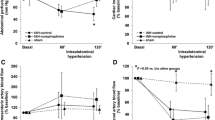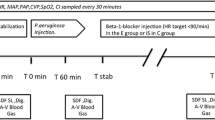Abstract
Objective
To investigate whether sympathetic blockade by means of thoracic epidural anaesthesia (TEA) increases intestinal perfusion during normotensive endotoxaemia.
Design
A prospective, randomised and controlled animal study.
Setting
Animal laboratory in a university hospital.
Subjects
Sprague-Dawley male rats.
Interventions
The rats were anaesthetised with urethane and ketamine, mechanically ventilated and haemodynamically monitored. Lidocaine or saline were infused continuously via thoracic epidural catheters followed by a continuous intravenous infusion of Escherichia coli lipopolysaccharide (1.5 mg/kg per h). Densities of perfused and non-perfused capillaries (i.e., with and without erythrocyte perfusion, respectively) as well as erythrocyte velocity in both the mucosa and the muscularis of the terminal ileum were determined using intravital microscopy.
Measurements and results
Measurements were performed at baseline, after 30 min of epidural infusion as well as after 60 and 120 min of lipopolysaccharide infusion. In animals receiving TEA, mean arterial pressure and heart rate were significantly reduced throughout the experiment. In the muscularis the endotoxaemia-induced increase in non-perfused capillaries was absent with epidural lidocaine (0 [0/0] versus 39 [36/137] cm-1, median [25th/75th percentile]), whereas in the mucosa perfused capillary density declined to a greater extent than in controls (−47 [−53/−23]%) versus −19 [−34/+10]%, p<0.05). Erythrocyte velocity decreased with endotoxaemia and was not influenced by epidural lidocaine.
Conclusions
Microvascular perfusion data during endotoxaemia show a redistribution of blood flow towards the mucosa. TEA seems to impede this redistribution resulting in improved muscularis and worsened mucosal microvascular perfusion.





Similar content being viewed by others
References
Sugita T, Watarida S, Katsuyama K, Nakajima Y, Yamamoto R, Matsuno S, Tabata R, Mori A (1998) Endotoxemia after elective surgery for abdominal aortic aneurysm and the effect of early oral feeding. J Cardiovasc Surg (Torino) 39:547–549
Kanwar S, Windsor AC, Welsh F, Barclay GR, Guillou PJ, Reynolds JV (2000) Lack of correlation between failure of gut barrier function and septic complications after major upper gastrointestinal surgery. Ann Surg 231:88–95
Christenson JT, Schmuziger M, Maurice J, Simonet F, Velebit V (1994) Postoperative visceral hypotension: the common cause for gastrointestinal complications after cardiac surgery. Thorac Cardiovasc Surg 42:152–157
Kienle P, Weitz J, Reinshagen S, Magener A, Autschbach F, Benner A, Stern J, Herfarth C (2001) Association of decreased perfusion of the ileoanal pouch mucosa with early postoperative pouchitis and local septic complications. Arch Surg 136:1124–1130
Carrico CJ, Meakins JL, Marshall JC, Fry D, Maier RV (1986) Multiple organ-failure syndrome. Arch Surg 121:196–208
Deitch EA (1990) The role of intestinal barrier failure and bacterial translocation in the development of systemic infection and multiple organ failure. Arch Surg 125:403–404
Johansson K, Ahn H, Lindhagen J, Tryselius U (1988) Effect of epidural anaesthesia on intestinal blood flow. Br J Surg 75:73–76
Kapral S, Gollmann G, Bachmann D, Prohaska B, Likar R, Jandrasits O, Weinstabl C, Lehofer F (1999) The effects of thoracic epidural anesthesia on intraoperative visceral perfusion and metabolism. Anesth Analg 88:402–406
Spackman DR, McLeod AD, Prineas SN, Leach RM, Reynolds F (2000) Effect of epidural blockade on indicators of splanchnic perfusion and gut function in critically ill patients with peritonitis: a randomised comparison of epidural bupivacaine with systemic morphine. Intensive Care Med 1638–1645
Sielenkamper AW, Eicker K, Van Aken H (2000) Thoracic epidural anesthesia increases mucosal perfusion in ileum of rats. Anesthesiology 93:844–851
Adolphs J, Schmidt DK, Mousa SA, Kamin B, Korsukewitz I, Habazettl H, Schafer M, Welte M (2003) Thoracic epidural anesthesia attenuates hemorrhage-induced impairment of intestinal perfusion in rats. Anesthesiology 99:685–692
Adolphs J, Schmidt DK, Mousa SA, Schafer M, Habazettl H, Welte M (2002) Thoracic epidural anesthesia prevents perfusion deficits in endotoxemic rats (abstract). Anesthesiology 96:A647
Nolte D, Zeintl H, Steinbauer M, Pickelmann S, Messmer K (1995) Functional capillary density: an indicator of tissue perfusion? Int J Microcirc Clin Exp 15:244–249
Freise H, Bruckner UB, Spiegel HU (2001) Animal models of sepsis. J Invest Surg 14:195–212
Longnecker DE, Harris PD (1980) Microcirculatory actions of general anesthetics. Fed Proc 39:1580–1583
Luebbe AS, Harris PD, Garrison RN (1998) E. Coli bacteremia-induced changes in the skeletal muscle microcirculation vary with anesthetics. Croat Med J 39:392–400
Bonica JJ (1968) Autonomic innervation of the viscera in relation to nerve block. Anesthesiology 29:793–813
Vagts DA, Iber T, Szabo B, Haberstroh J, Reising K, Puccini M, Geiger K, Noldge-Schomburg GF (2003) Effects of epidural anaesthesia on intestinal oxygenation in pigs. Br J Anaesth 90:212–220
Lundberg J, Lundberg D, Norgren L, Ribbe E, Thorne J, Werner O (1990) Intestinal hemodynamics during laparotomy: effects of thoracic epidural anesthesia and dopamine in humans. Anesth Analg 71:9–15
Aitkenhead AR, Gilmour DG, Hothersall AP, Ledingham IM (1980) Effects of subarachnoid spinal nerve block and arterial PCO2 on colon blood flow in the dog. Br J Anaesth 52:1071–1077
Lundberg J, Biber B, Henriksson BA, Martner J, Raner C, Werner O, Winso O (1991) Effects of thoracic epidural anesthesia and adrenoceptor blockade on the cardiovascular response to dopamine in the dog. Acta Anaesthesiol Scand 35:359–365
Otton PE, Wilson EJ (1966) The cardiocirculatory effects of upper thoracic epidural analgesia. Can Anaesth Soc J 13:541–549
Hogan QH, Stadnicka A, Stekiel TA, Bosnjak ZJ, Kampine JP (1993) Effects of epidural and systemic lidocaine on sympathetic activity and mesenteric circulation in rabbits. Anesthesiology 79:1250–1260
Schmidt H, Secchi A, Wellmann R, Bach A, Bhrer H, Martin E (1996) Dopexamine maintains intestinal villus blood flow during endotoxemia in rats. Crit Care Med 24:1233–1237
Xu D, Qi L, Guillory D, Cruz N, Berg R, Deitch EA (1993) Mechanisms of endotoxin-induced intestinal injury in a hyperdynamic model of sepsis. J Trauma 34:676–682
Feuk U, Jakobson S, Norlen K (1987) The effects of alpha adrenergic blockade on central haemodynamics and regional blood flows during positive pressure ventilation. An experimental study in the pig. Acta Anaesthesiol Scand 31:748–755
Schulte-Steinberg O, Rahlfs VW (1977) Spread of extradural analgesia following caudal injection in children. A statistical study. Br J Anaesth 49:1027–1034
Hahn RG (1992) Haemoglobin dilution from epidural-induced hypotension with and without fluid loading. Acta Anaesthesiol Scand 36:241–244
Holte K, Foss NB, Svensen C, Lund C, Madsen JL, Kehlet H (2004) Epidural anesthesia, hypotension and changes in intravascular volume. Anesthesiology 100:281–286
Van Bommel J, Siegemund M, Henny CP, Trouwborst A, Ince C (2001) Critical hematocrit in intestinal tissue oxygenation during severe normovolemic hemodilution. Anesthesiology 94:152–160
Granger DN, Kvietys PR, Perry MA (1982) Role of exchange vessels in the regulation of intestinal oxygenation. Am J Physiol 242:G570–G574
Gosche JR, Garrison RN (1991) Prostaglandins mediate the compensatory responses to hemorrhage in the small intestine of the rat. J Surg Res 50:584–588
Hiltebrand LB, Krejci V, tenHoevel ME, Banic A, Sigurdsson GH (2003) Redistribution of microcirculatory blood flow within the intestinal wall during sepsis and general anesthesia. Anesthesiology 98:658–669
Revelly JP, Ayuse T, Brienza N, Fessler HE, Robotham JL (1996) Endotoxic shock alters distribution of blood flow within the intestinal wall. Crit Care Med 24:1345–1351
Massberg S, Eisenmenger S, Enders G, Krombach F, Messmer K (1998) Quantitative analysis of small intestinal microcirculation in the mouse. Res Exp Med (Berl) 198:23–35
Neviere RR, Pitt-Hyde ML, Piper RD, Sibbald WJ, Potter RF (1999) Microvascular perfusion deficits are not a prerequisite for mucosal injury in septic rats. Am J Physiol 276:G933–G940
Lazar G, Kaszaki J, Abraham S, Horvath G, Wolfard A, Szentpali K, Paszt A, Balogh A, Boros M (2003) Thoracic epidural anesthesia improves the gastric microcirculation during experimental gastric tube formation. Surgery 134:799–805
Gould TH, Grace K, Thorne G, Thomas M (2002) Effect of thoracic epidural anaesthesia on colonic blood flow. Br J Anaesth 89:446–451
Kennedy WF Jr, Everett GB, Cobb LA, Allen GD (1971) Simultaneous systemic and hepatic hemodynamic measurements during high peridural anesthesia in normal man. Anesth Analg 50:1069–1077
Acknowledgements
We are indebted to Ursula Hilse, medical technician, for expert technical assistance. We also wish to thank Christoph Stein, M.D., Department of Anaesthesiology and Axel R. Pries, M.D., Institute of Physiology, both Charité—Universitätsmedizin Berlin, Campus Benjamin Franklin, for support and critical review of the manuscript.
Author information
Authors and Affiliations
Corresponding author
Rights and permissions
About this article
Cite this article
Adolphs, J., Schmidt, D.K., Korsukewitz, I. et al. Effects of thoracic epidural anaesthesia on intestinal microvascular perfusion in a rodent model of normotensive endotoxaemia. Intensive Care Med 30, 2094–2101 (2004). https://doi.org/10.1007/s00134-004-2426-y
Received:
Accepted:
Published:
Issue Date:
DOI: https://doi.org/10.1007/s00134-004-2426-y




